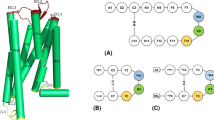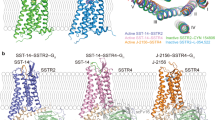Abstract
The G protein coupled receptor(GPCR), one of the members in the superfamily, which consists of thousands of integral membrane proteins, exerts a wide variety of physiological functions and responses to a large portion of the drug targets. The 3D structure of somatostatin receptor 1(SSTR1) was modeled and refined by means of homology modeling and molecular dynamics simulation. This model was assessed by Verify-3D and Vadar, which confirmed the reliability of the refined model. The interaction between the inhibitor cysteamine, somatostatin(SST) and SSTR1 was investigated by a molecular docking program, Affinity. The binding module not only showed the crucial residues involved in the interaction, but also provided important information about the interaction between SSTR1 on the one hand and ligands on the other, which might be the significant evidence for the structure-based design.
Similar content being viewed by others
References
Zhong C., Ding J., Acta Biochim. Biophys. Sin., 2011, 43, 337
Wu B. L., Chien E. Y. T., Mol C. D., Fenalti G., Liu W., Katritch V., Abagyan R., Brooun A., Wells P., Bi C. F., Hamel D. J., Kuhn P., Handel T. M., Cherezov V., Stevens R. C., Science, 2010, 330, 1066
Baggiolini M., Nature, 1998, 392, 565
Moser B., Wolf M., Walz A., Loetscher P., Trends Immunol., 2004, 25, 75
Mackay C. R., Nat. Immunol., 2001, 2, 95
Congreve M., Marshall F., Br. J. Pharmacol., 2010, 159, 986
Watt H. L., Kharmate G. D., Kumar U., Cell Signal., 2009, 21, 428
Zatelli M. C., Piccin D., Tagliati F., Ambrosio M. R., Margutti A., Padovani R., Scanarini M., Culler M. D., degli Uberti E. C., J. Clin. Endocrinol. Metab., 2003, 88, 2797
Liapakis G., Tallent M., Reisine T., Metabolism, 1996, 45, 12
Reynisdottir I., Massagué J., Genes. Dev., 1997, 11, 492
Altschu S. F., Madden T. L., Schäffer A. A., Zhang J., Zhang Z., Miller W., Lipman D. J., Nucleic. Acid Res., 1997, 25, 3389
Marklund S., Tuggle C. K., Rothschild M. F., Anim. Genet., 2000, 31, 318
Schwede T., Kopp J., Guex N., Peitsch M. C., Nucleic. Acids Res., 2003, 31, 3381
Guex N., Peitsch M. C., Electrophoresis, 1997, 18, 2714
Arnold K., Bordoli L., Kopp J., Schwede T., Bioinformatics, 2006, 22, 195
Zhan D., Han W. W., Feng Y., J. Mol. Model., 2011, 17, 1241
Kiefer F., Arnold K., Künzli M., Bordoli L., Schwede T., Nucleic. Acids Res., 1995, 37, D387
Arnold K., Bordoli L., Kopp J., Schwede T., Bioinformatics, 2006, 22, 195
Gruber C. C., Pleiss J., J. Comput. Chem., 2011, 32, 600
Jorgensen W. L., Chandrasekhar J., Madurs J., Impey R. W., Klein M. L., J. Chem. Phys., 1983, 79, 926
Binding Site Analysis User Guide, Accelrys Inc., San Diego, 1999
Dundas J., Zheng O., Tseng J., Binkowski A., Turpaz Y., Liang Y., Nucleic. Acids Res., 2006, 34, W116
Trott O., Olson A.J., J. Comput. Chem., 2010, 31, 455
Affinity User Guide, Accelrys Inc., San Diego, 1999
Han W. W., Zhan D. L., Zhao X., Wang S., Chem. Res. Chinese Universities, 2010, 26(1), 128
Han W. W., Wang Y., Luo Q., Feng Y., J. Chem. Theory. Comput., 2011, 10, 165
Han W. W., Zhou Y. H., Luo Q., Yao Y., Li Z. S., Polymer, 2007, 48, 3726
Han W. W., Wang Y., Zhou Y. H., Yao Y., Li Z. S., Feng Y., J. Mol. Model., 2009, 15, 481
Author information
Authors and Affiliations
Corresponding authors
Additional information
Supported by the National Basic Research Program of China(No.2012CB721003) and the National Natural Science Foundation of China(Nos.30871842, 20333050, 20073014).
Rights and permissions
About this article
Cite this article
Lan, Hn., Wang, Yx., Zheng, Mz. et al. Using homology modeling, molecular dynamics and molecular docking techniques to identify inhibitor binding regions of somatostatin receptor 1. Chem. Res. Chin. Univ. 29, 139–143 (2013). https://doi.org/10.1007/s40242-013-2103-1
Received:
Accepted:
Published:
Issue Date:
DOI: https://doi.org/10.1007/s40242-013-2103-1




